

I have neglected Jupiter for three years because it was so far below the equator that it never rose high enough in my skies for imaging. This year it has reached a high enough declination for me to see it from my observatory. And what an unusual sight it is! What has happened to the South Equatorial Belt?
For some images extra information is available if you move your mouse over the image.
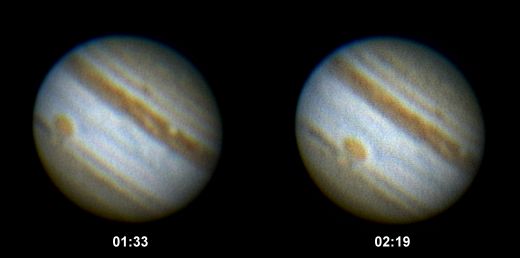 |
This is my first attempt of the season. I started imaging as soon as Jupiter cleared my local horizon when its altitude was 36°. These two pictures were taken 46 minutes apart and you can see how much the planet has rotated in that time. Notice too that the southern equatorial belt is missing. (For comparison see one of my earlier images.) Normally the great red spot, clearly seen here, is on the southern edge of the belt. It has been gone for some time and nobody knows why or when it might return. Date and Time: 19th August 2010 10:33 and 02:19 UT Camera: ToUcam 840K (colour) Telescope: LX200 with X2 SLR lens Capture: K3CCDTools. Low gamma, 1/25" gain 12%, and 1/25" gain 0% Processing: Registax. 93 and 101 frames stacked. Wavelets 1-3 =10, gamma 0.9, histogram 0-200. | |
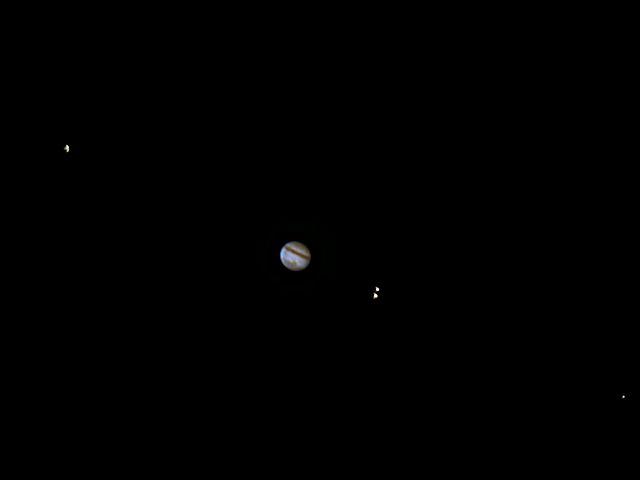 |
And here he is with his four largest satellites. Move you mouse over the image to see their names. This is a composite of two exposures, one to image the satellites and one to resolve the planet. Date and Time: 19th August 2010 10:33 and 02:36 and 02:43 UT Camera: ToUcam 840K (colour) Telescope: LX200 with 0.33 focal reducer Capture: K3CCDTools. Satellites: high gamma, 1/50", 17% gain Planet: low gamma, 1/500", gain 0% Processing: Registax. Satellites: 100 frames stacked, wavelets 1-2 = 5, Planet: 101 frames stacked, wavelets 1-2 = 5, gamma 0.9 | |
| The next three images were made on 24th August 2010 and show a transit of the shadow of Io. | ||
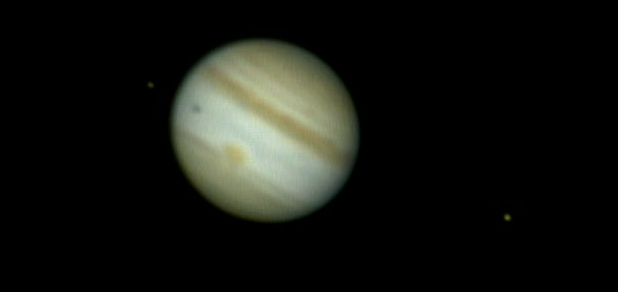 |
Imaged 5 days after the picture above, the shadow of Io is in transit across the face of Jupiter. Io itself is the tiny dot to the west (left) of the planet and the shadow is the dark spot. The other satellite in the picture is Europa. Date and Time: 24th August 2010 01:25 UT Camera: ToUcam 840K Telescope: LX200 with X2 lens Capture: K3CCDTools. High gamma, 1/33", 0% gain, 453 frames Processing: Registax. 151 frames stacked, wavelets 1-3 = 10, histogram 0-180, gamma 0.6 | |
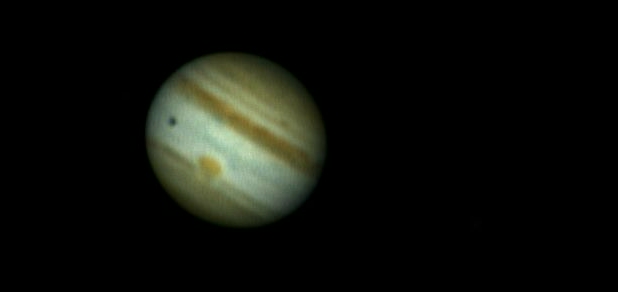 |
It is difficult to obtain an image showing both the satellites and the details on the planet together. So here is an image made a little later and processed to bring out the detail on the planet. Date and Time: 24th August 2010 01:29 UT Camera: ToUcam 840K Telescope: LX200 with X2 lens Capture: K3CCDTools. Low gamma, 1/33", 9% gain, 453 frames Processing: Registax. 129 frames stacked, wavelets 1-3 = 10, histogram 0-190, gamma 0.8 | |
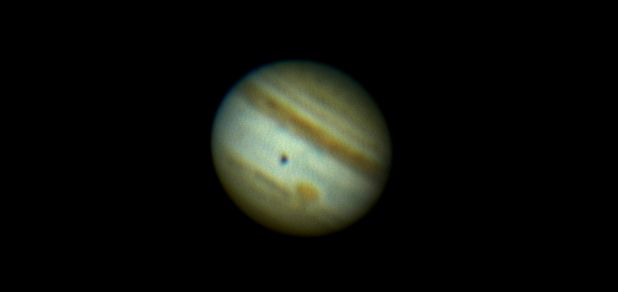 |
And finally a picture taken 40 minutes later showing the rotation of the planet and the fact that the shadow is moving faster than the surface. Io was also in transit this time, but I cannot see it in my image. It is very small at 1.2 arc-seconds, and the shadow appears much bigger than this (approximately 10 arc-seconds). The umbral shadow cannot be bigger than the object casting it, but the penumbral shadow can be. Date and Time: 24th August 2010 02:10 UT Camera: ToUcam 840K Telescope: LX200 with X2 lens Capture: K3CCDTools. Low gamma, 1/33", 9% gain, 452 frames Processing: Registax. 411 frames stacked, wavelets 1-3 = 10, histogram 0-185, gamma 0.8 | |
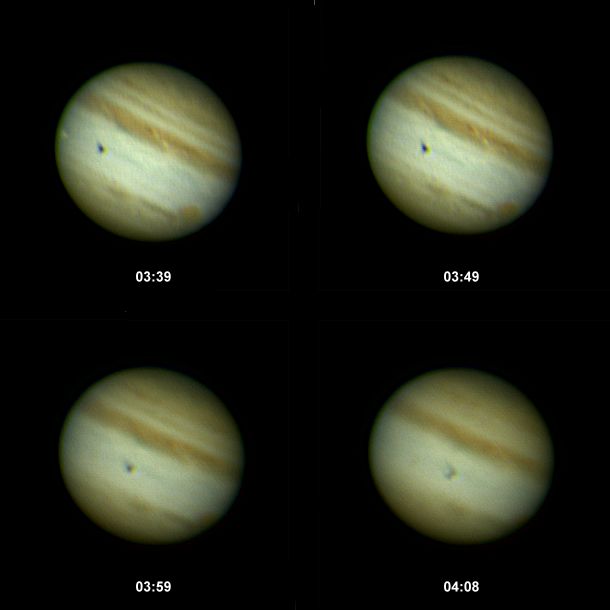 |
Another shadow transit of Io. This time I wanted to make an animation, but things didn't work out too well. Jupiter was getting too low in an ever-brightening sky and, as you can see, the quality of the pictures was getting quite bad. The bright spot on the limb to the left of the shadow is Io itself. If I animate the sequence I believe I can see Io on the other images too (but this may be wishful thinking!) Date and Time: 31st August 2010 03:38 to 04:08 UT Camera: ToUcam 840K Telescope: LX200 with X2 lens Capture: K3CCDTools. Low gamma, 1/33", 10% gain, ~475 frames Processing: Registax. 100 frames stacked, wavelets 1-2 = 10, histogram 0-190 | |
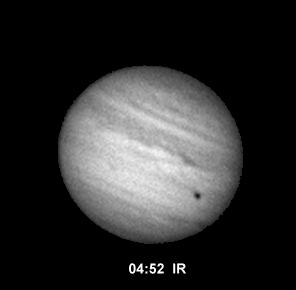 |
A final picture taken some 40 minutes later. This one was taken at the prime focus and in infra-red light in order to overcome the ever-brightening sky. The picture has been magnified X2 to make it the same size as those above. This picture in included in the animation mentioned above. Date and Time: 31st August 2010 04:52 UT Camera: DMK 21AF04 Telescope: LX200 at prime focus Capture: ICcapture. 1/77", gain 870, 3494 frames Processing: Registax. 99 frames stacked, wavelets 1-2 = 10, X2 | |
Below are seven images of Jupiter taken during a transit of Europa. The shadow of Europa is clearly visible; the satellite itself is slightly to the left of the shadow, but is not visible in the images. Three of the images were exposed and processed to reveal the other Galilean satellites and you can see these by clicking on any image that causes the cursor to change to a pointer. The best of these images are those at 00:51 and 01:02. The former was taken in infra-red light and the satellites always show up more easily in this colour. Using the colour camera I had to over-expose the planet very slightly in order to reveal Callisto which is significantly fainter than the others. This later image also identifies the satellites.
Although the pictures below were taken in 2011, I am including them here as it is part of the same season for imaging Jupiter. The first picture is a composite and a mosaic of three pictures. The satellites were close enough to capture at prime focus in two exposures. In order to reveal Callisto, I had to overexpose the planet, so I have superimposed a correctly-exposed picture of Jupiter over the over-exposed image. Move your mouse over the image to see the names of the satellites.
Those who image Jupiter with more detail than I can manage say that the southern equatorial belt is returning. I still see very little evidence of it, although I do see a slightly darker streak which is not the Great Red Spot.
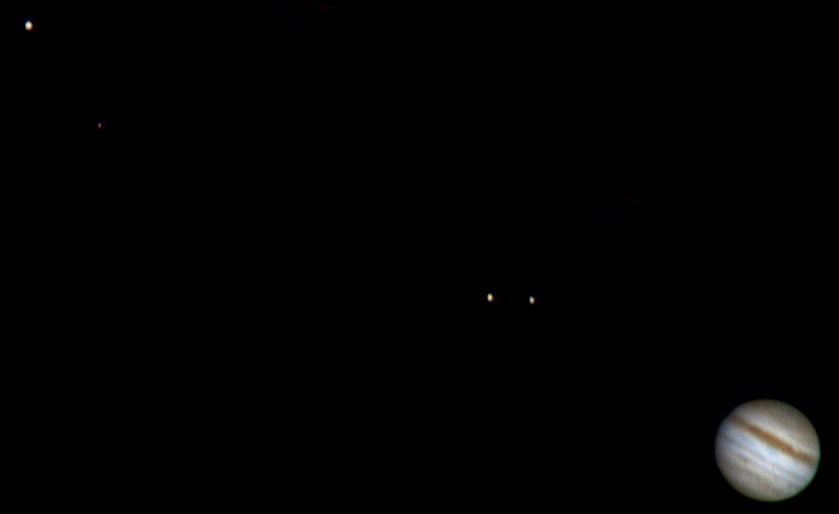
Date and Time: 8th January 2011 18:12 to 18:18 UT
Camera: Toucam 840K
Telescope: LX200
Capture: K3CCDTools. Jupiter 1/25", 15% gain, low gamma, 607 frames
Satellites 1/25", 40% gain, high gamma, 602 frames
Processing: Registax. Jupiter 362 frames stacked, wavelets 1-2=10, histogram 0-165
Satellites, 102 frames stacked, wavelets 1-2=10.
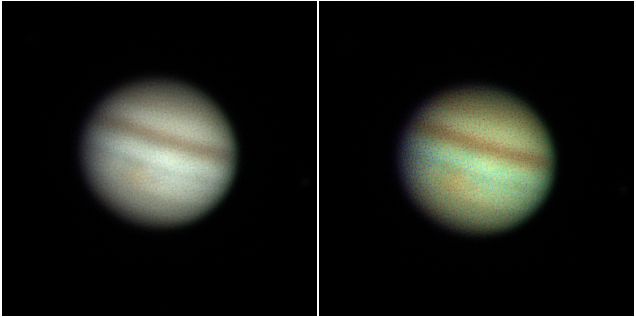 |
Conditions were very poor when I took this picture with lots of light cloud about so I had to grab frames between the clouds. However this was my first chance to try out my new DFK 21AF04.AS camera, so I had to try it out. I don't think these pictures are representative of what the camera is capable. It has two modes of operation, colour or raw (which has to be debayered on the computer). This picture was made in colour mode. The one on the left is the original image, processed as below; the one on the right is the same one with the colour saturation increased 20%. Date and Time: 18th January 2011 17:58 Camera: DFK 21AF04 (colour) Telescope: LX200 with X2 SLR lens Capture: ICCapture. 3184 frames in 2 minutes (~26 frames per sec*), 1/38", gain 905, gamma 22 Processing: Registax. 99 frames stacked. Wavelets 1-2 = 10, gamma 0.8, histogram 0-206. * This is 5 times what I get from my ToUcam. |